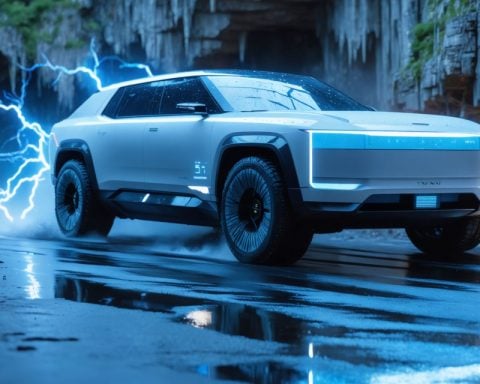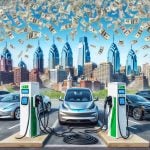- China’s CATL is expanding aggressively into Europe’s clean mobility sector with a $5 billion Hong Kong listing, planning a major battery plant in Hungary.
- The Hungarian facility aims to produce 100 gigawatt-hours annually, powering over 100,000 electric vehicles (EVs) and serving clients like Mercedes-Benz, BMW, and Volkswagen.
- South Korean battery companies are closely watching CATL’s moves, relying on legacy relationships with automakers to maintain their market position.
- Hungary’s central location, EV subsidies, and investment benefits make it a strategic hub for CATL, aligning with Europe’s 2035 combustion engine phase-out plan.
- CATL’s expansion reflects a shift in global battery dynamics, influencing the future of clean mobility and the international energy landscape.
In the heart of Europe, a silent revolution unfolds. China’s Contemporary Amperex Technology Co. Limited (CATL), the world titan of electric vehicle (EV) batteries, has set its sights on expansion in the burgeoning European clean mobility sector. To fuel this ambition, CATL seeks a robust $5 billion from a Hong Kong listing, eyeing significant growth in Hungary with a state-of-the-art battery plant.
This endeavor is no small feat. The upcoming Hungarian facility promises to churn out 100 gigawatt-hours annually, energizing over 100,000 EVs. With names like Mercedes-Benz, BMW, and Volkswagen in its client roster, CATL’s presence resonates through the European auto industry.
Yet, amid this electrifying development, other players buzz with both intrigue and trepidation. South Korean battery giants, long-time partners of European automakers, observe CATL’s moves with cautious eyes. They view their legacy relationships as a safety net against CATL’s encroaching influence, but the subtle shifts in alliances, such as Mercedes-Benz opting for CATL’s cost-effective lithium iron phosphate batteries, hint at an evolving landscape.
Hungary’s allure goes beyond its central location. Offering EV consumer subsidies and enticing investment perks, the nation positions itself as a hub for battery innovation, aligning with Europe’s aggressive push to phase out internal combustion engines by 2035. As US-China geopolitical tensions simmer, Europe has become a strategic focus for CATL’s international aspirations.
This isn’t merely a quest for market share. CATL’s bold expansion underscores a pivotal shift in global battery dynamics, reshaping alliances and sparking technological advancements. The path CATL carves through Europe will likely influence the future of clean mobility, emphasizing the ever-shifting balance in the worldwide energy arena.
How China’s EV Battery Giant is Transforming Europe’s Clean Mobility Scene
How-To Steps & Life Hacks
To understand and engage with the growing electric vehicle (EV) market, consider these steps:
1. Research EV Incentives: Different European countries offer various incentives for EV adoption, including tax credits, subsidies, and rebates. Familiarize yourself with these to leverage available benefits.
2. Evaluate Charging Infrastructure: Assess the local and regional availability of EV charging stations. Locations with robust infrastructure, such as Hungary, enhance EV ownership convenience.
3. Select the Right Battery Technology: With CATL’s move towards lithium iron phosphate batteries, consider how this technology aligns with your needs, focusing on cost, performance, and longevity.
4. Stay Updated on Market Trends: As battery technology rapidly evolves, keep informed about advancements and partnerships shaping the sector, like the collaboration between CATL and European automakers.
Real-World Use Cases
1. Automaker Partnerships: CATL’s collaboration with Mercedes-Benz, BMW, and Volkswagen exemplifies strategic alliances forming across the automotive and battery manufacturing sectors, enhancing EV production.
2. Sustainable Energy Solutions: By establishing large-scale battery production in Hungary, CATL supports Europe’s transition toward clean energy and transportation, contributing to environmental sustainability goals.
Market Forecasts & Industry Trends
The global EV battery market is projected to grow significantly, with a CAGR of over 20% from 2021 to 2030. Europe, with its commitment to banning internal combustion engines by 2035, is pivotal in this growth. CATL’s expansion positions it to capture a significant portion of this burgeoning market.
Reviews & Comparisons
While CATL leads in global battery production, competitors like LG Energy Solution and Panasonic offer distinct advantages. CATL’s focus on lithium iron phosphate batteries provides cost benefits, while others prioritize high-energy density solutions.
Controversies & Limitations
The geopolitical landscape, particularly US-China tensions, presents a potential hurdle for companies like CATL operating internationally. Moreover, Europe’s regulatory and political environment might pose challenges.
Features, Specs & Pricing
CATL’s batteries are known for their reliability and efficiency. With plans to produce 100 gigawatt-hours annually from the Hungarian plant, they offer competitive pricing, aided by cost-effective production techniques.
Security & Sustainability
CATL emphasizes sustainability in production, reducing carbon footprints by utilizing renewable energy sources. The company also invests in battery recycling, aiming to minimize environmental impact.
Insights & Predictions
The European EV market is expected to double by the end of the decade. CATL’s strategic moves, particularly in Hungary, hint at stronger ties with European automakers and expanded market dominance.
Tutorials & Compatibility
For businesses entering the EV battery space, understanding compatibility with existing vehicle platforms is crucial. CATL’s collaborations often include technical support, fostering seamless integration.
Pros & Cons Overview
Pros:
– Cost-effective battery solutions
– Strong partnerships with leading automakers
– Strategic location in Hungary enhances market reach
Cons:
– Geopolitical risks could affect operations
– Competition from established players in Europe
– Regulatory hurdles in new markets
Actionable Recommendations
– Invest in EV Technology: For consumers and investors, focusing on EV ecosystems by investing in stocks, or partaking in subsidies, could yield long-term benefits.
– Monitor Industry Alliances: Track partnerships between battery manufacturers and automakers to identify market leaders and potential investment opportunities.
– Adopt Sustainable Practices: Companies should align with sustainable practices, similar to CATL’s focus on recycling and renewable energy, to stay competitive and minimize environmental impact.
For further insights, visit the Contemporary Amperex Technology Co. Limited website to explore more about their innovations and partnerships in the clean mobility sector.



















